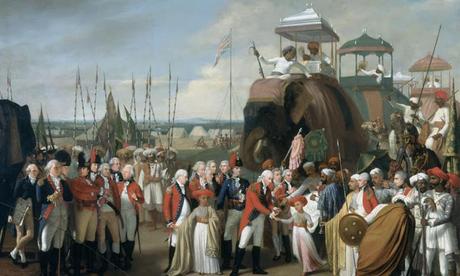History offers interesting lessons – for when we search and learn something, we understand that what we heard in the past in Schools and Colleges was far different from the truth !!
Ever heard of the ‘Trunajaya rebellion’ an unsuccessful rebellion waged by the Madurese prince Trunajaya and fighters from Makassar against the Mataram Sultanate and its Dutch East India Company (VOC) ! - if your mind referred to the colonisers East India Company, please do read on further.

The ships of East India Company docked at Surat in Gujarat in 1608. The company established its first Indian factory in 1611 at Masulipatnam on the Andhra Coast of the Bay of Bengal, and its second in 1615 at Surat. The high profits reported by the company after landing in India initially prompted James I to grant subsidiary licences to other trading companies in England. However, in 1609 he renewed the East India Company's charter for an indefinite period, with the proviso that its privileges would be annulled if trade was unprofitable for three consecutive years.
In 1615, James I instructed Sir Thomas Roe to visit the Mughal Emperor Nur-ud-din Salim Jahangir to arrange for a commercial treaty that would give the company exclusive rights to reside and establish factories in Surat and other areas. In return, the company offered to provide the Emperor with goods and rarities from the European market. That single mistake proved too costly as the Nation became a colony for 3 centuries !!
The East India Company (EIC) was an English, and later British, joint-stock company founded in 1600 and dissolved in 1874, formed to trade in the Indian Ocean region, initially with the East Indies (the Indian subcontinent and Southeast Asia), and later with East Asia. The company seized control of large parts of the Indian subcontinent and colonised parts of Southeast Asia and Hong Kong. None asked why traders had their own armed forces in the form of the company's three Presidency armies, totalling about 260,000 soldiers, twice the size of the British army at the time. The primary aim was to deal in commodities including cotton, silk, indigo dye, sugar, salt, spices, saltpetre, tea, and opium, but they ruled large areas of India, exercising military power and assuming administrative functions. Company rule in India effectively began in 1757 after the Battle of Plassey and lasted until 1858. Following the Indian Rebellion of 1857, the Government of India Act 1858 led to the British Crown assuming direct control of India in the form of the new British Raj.
The Company grew in monstrous proportions yet had financial troubles and was eventually dissolved in 1874 as the East India Stock Dividend Redemption Act rendered it vestigial, powerless, and obsolete. The official government machinery of the British Raj had assumed its governmental functions and absorbed its armies.
What missed our attention is “East India Company” is a general term, referring to a number of European trading companies established for trade relations and subsequently political control over the Indian subcontinent, the Indonesian archipelago and the neighboring lands in Southeast Asia. They would include: British, Dutch, Danish, Portuguese, Genoese, French, Swedish and Austrian – East India Companies !!!!!
The United East India Company was a chartered company established in 1602 by the States General of the Netherlands amalgamating existing companies into the first joint-stock company in the world, granting it a 21-year monopoly to carry out trade activities in Asia. Shares in the company could be bought by any resident of the United Provinces and then subsequently bought and sold in open-air secondary markets. Statistically, the VOC eclipsed all of its rivals in the Asia trade. Between 1602 and 1796 the VOC sent almost a million Europeans to work in the Asia trade on 4,785 ships, and netted for their efforts more than 2.5 million tons of Asian trade goods.
The VOC established a capital in the port city of Jayakarta in 1609 and changed its name to Batavia (now Jakarta). Over the next two centuries the company acquired additional ports as trading bases and safeguarded their interests by taking over surrounding territory. Weighed down by smuggling, corruption and growing administrative costs in the late 18th century, this company went bankrupt and was formally dissolved in 1799. Its possessions and debt were taken over by the government of the Dutch Batavian Republic.
The Trunajaya rebellion was the unsuccessful rebellion waged by the Madurese prince Trunajaya and fighters from Makassar against the Mataram Sultanate and its Dutch East India Company (VOC) supporters in Java (in modern-day Indonesia) during the 1670s. The uprising was initially successful; the rebels gained Gegodog (1676), the majority of Java's north coast (1677), and the capital of Mataram (1677) from the royal army. During the retreat of the royal court, King Amangkurat I passed away. Amangkurat II, his son and successor, asked the VOC for assistance in exchange for cash payments and geopolitical renunciations. The subsequent engagement of the VOC changed the course of the battle. Trunajaya was driven from Surabaya by VOC and Mataram forces, who also helped him reclaim lost territory and take control of his new capital at Kediri (1678). However, the uprising persisted until Trunajaya was captured at the end of 1679 and the other rebel leaders were overthrown, killed, or submitted.
Very similar story of East India Company creating turmoil, making clans rebel, support one side and eventually dismiss both sides, claiming possession and ruling over them. Colonisation !! – and we believed them to be masters compassionate and those who provided us wealth and knowledge, when in reality they were looting us.
With regards – S. Sampathkumar
4th May 2023

